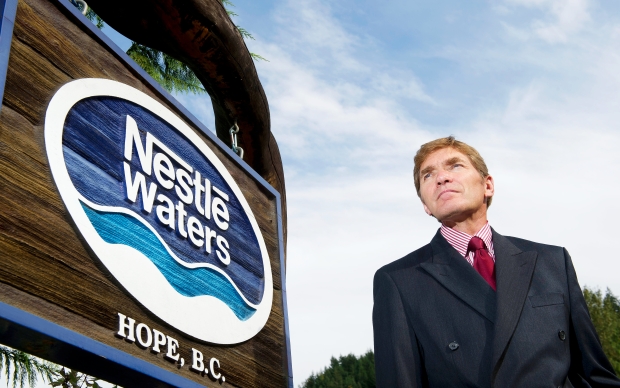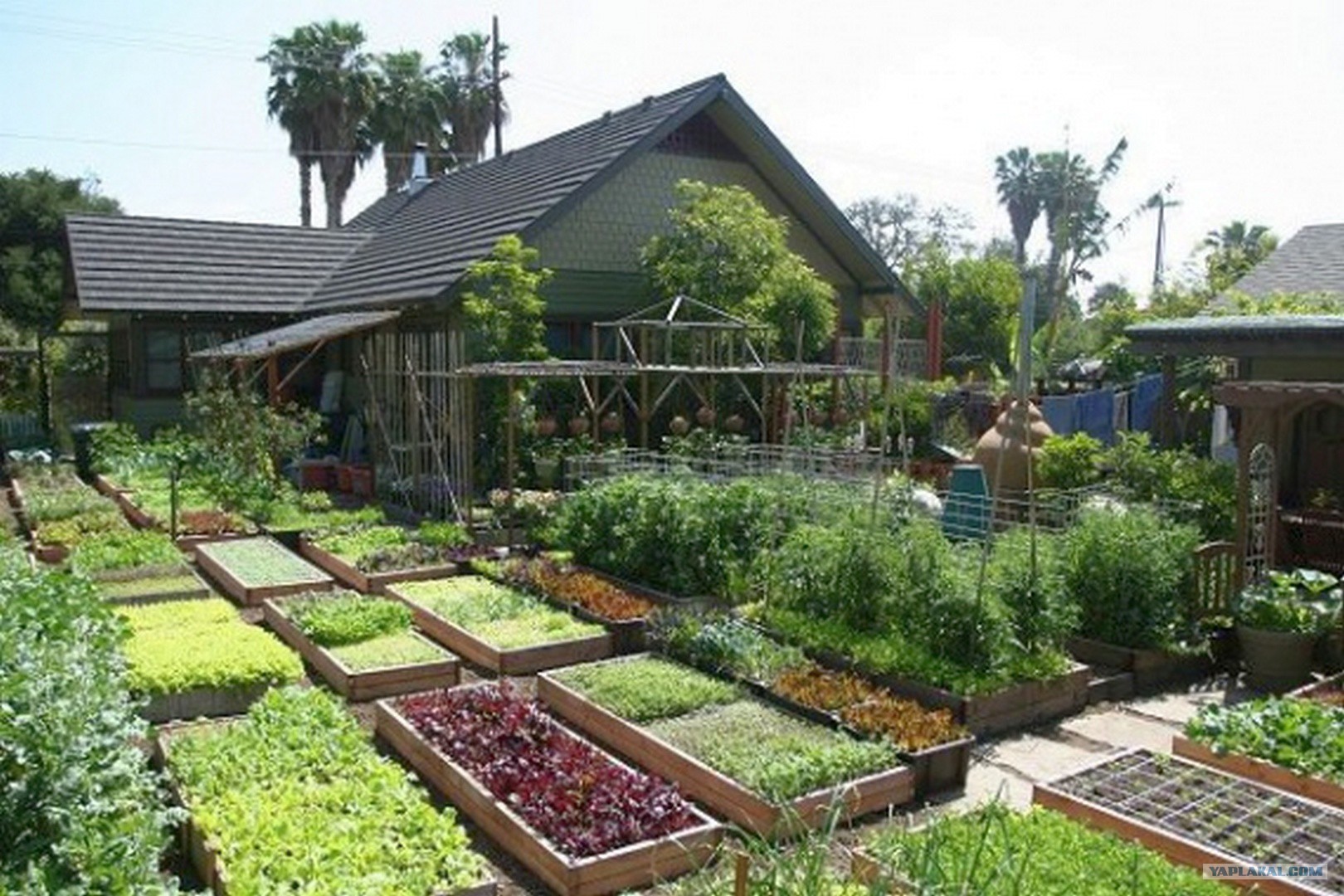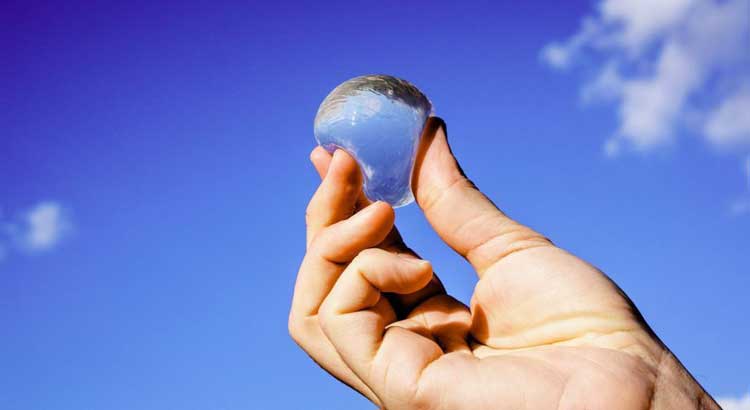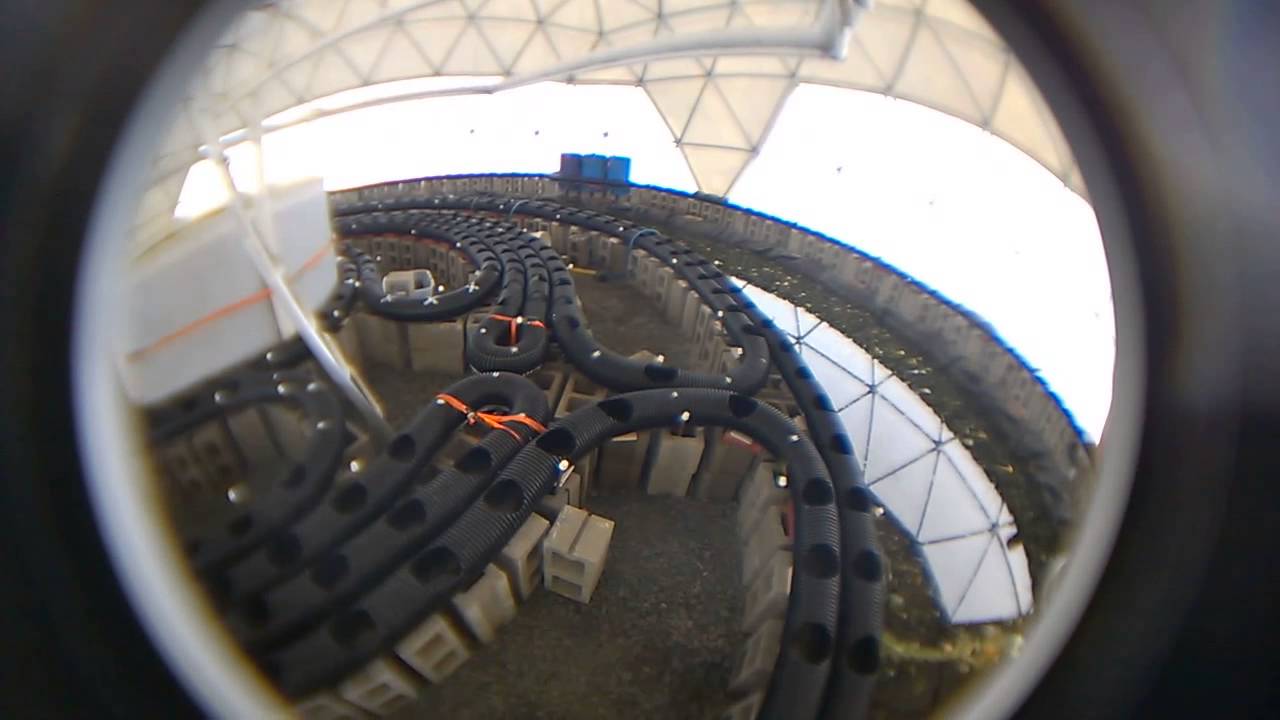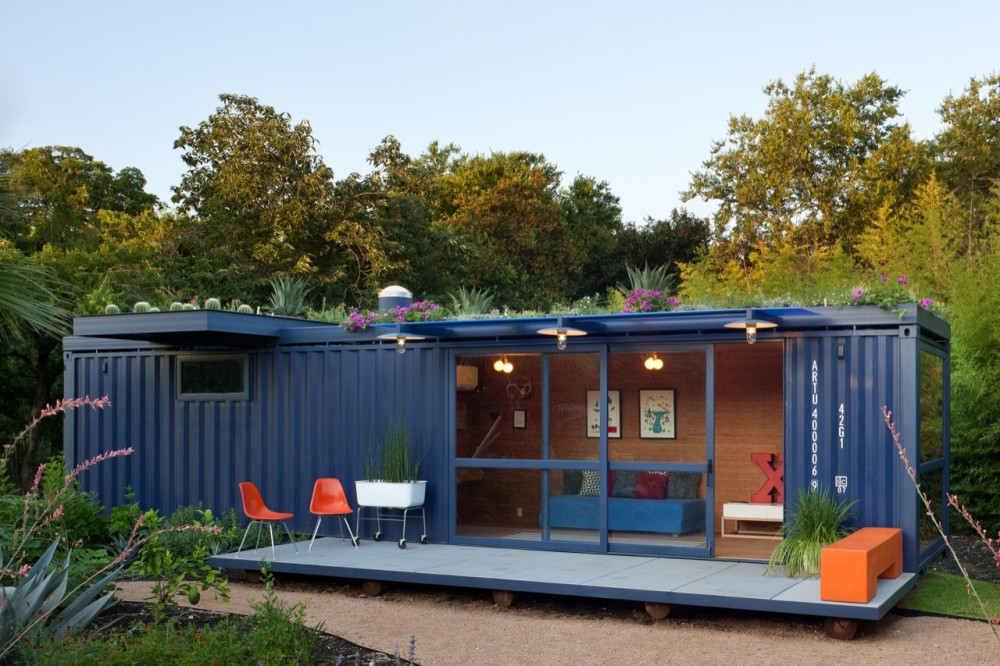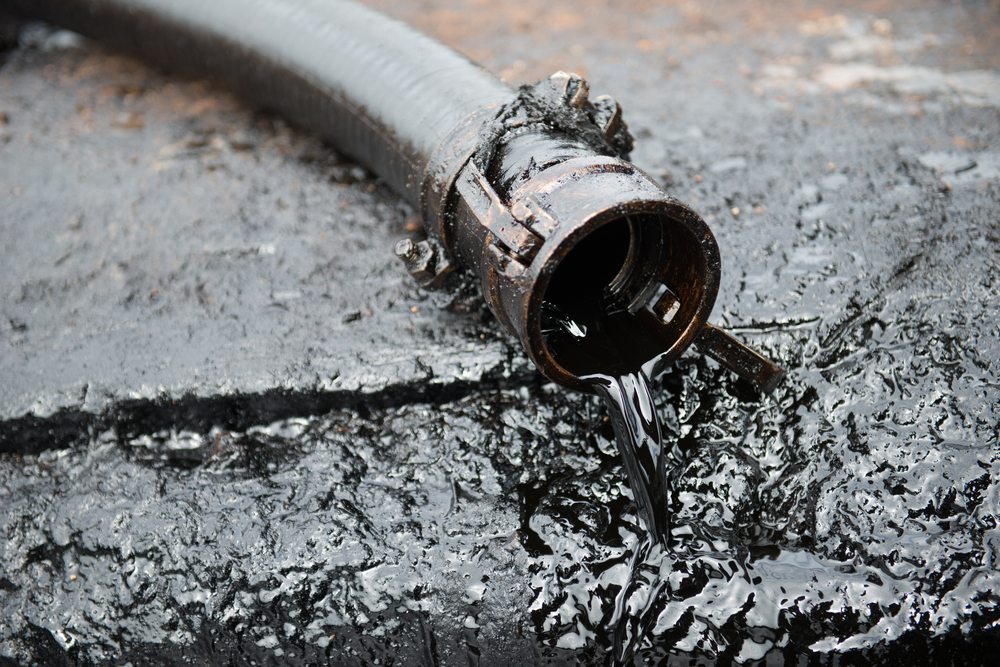Check Out This Highway Billboard That Grows Organic Lettuce and Generates Drinking Water
We’ve seen vertical farms before, but this brings urban agriculture quite literally to the next level. In the Bujama region of Lima, Peru, thousands of lettuce heads are sprouting next to a major highway thanks to a very unusual source: a billboard.
FCB Mayo Peru and University of Engineering & Technology (UTEC)-the minds behind an innovative billboard that’s sucking up Lima’s notorious pollution and another billboard that’s turning the city’s humid air into drinking water -have come up with the “Air Orchard” billboard that can generate pollution-free produce.
We all know that this isn’t just any old advertisement by the side of the road. So how does it work? The concept is actually very simple to anyone familiar with the soil-free farming method of hydroponics. Sitting behind the billboard’s panel are 10 large dehumidifiers that draw in water from the air and turn it into potable water. This water then drips down a series of PVC tubes that are coated in nutrients. The tubes are also white to reflect the sun’s rays and boost photosynthesis. Air Orchard’s system is simply an adaptation of the “nutrient film technique” of hydroponics, in which plants’ roots can constantly access a recirculating stream of fertilizer-rich water.
The billboard is located on Peru’s largest and most important highway, the Panamericana Sur, and is already in operation. According to a press release, more than 2,800 heads of lettuce are given away weekly to passersby and the local community from the Air Orchard-all for free.
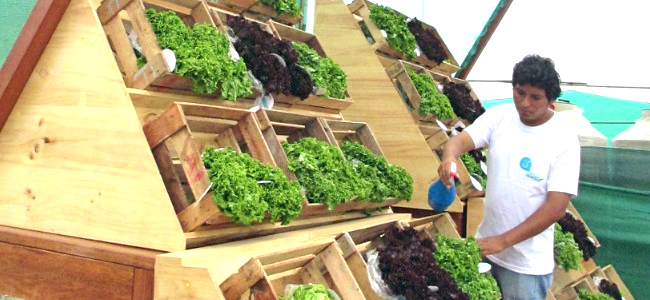
“Currently, organic products are gaining significance, compared to chemically treated products. UTEC wanted to work out the most efficient way to grow a crop of 2,000 heads of lettuce using the clean water generated by the panel,” said Jessica Ruas, UTEC marketing director in a statement. “In addition to growing lettuce, the billboard still produces 96 liters of drinking water a day to provide for the surrounding community.”
This technique solves a pressing problem in the area. As the video below pointed out, water that’s used for irrigating Bujama’s fields are highly contaminated with arsenic, lead or cadmium that can seep into nearby farmland and crops. Consequently, this means the majority of the vegetables consumed in Lima are contaminated.
“UTEC is a university that was founded with the mission of developing applied research that provides practical solutions to the challenges of society and industry,” said Ignacio Montero, director of business innovation at UTEC in a statement. “These principles are proven through innovative initiatives like the ‘Air Orchard.’ We improved on our first panel that generated water from moisture in the air for human consumption and increased the production of water to grow healthy food. We have found a practical solution to a real problem, and through creativity and innovation we developed solutions to the challenges of our country and the world.”
Now imagine eating fresh vegetables from a billboard on a highway near you.
Outrage boils over as B.C. government plans to sell groundwater for $2.25 per million litres
More than 82,000 people have signed a petition against the government’s plans to sell B.C.’s water for $2.25 per million litres.
“It is outrageous,” says the online petition from SumOfUs.org, that corporations can buy water “for next to nothing.”
B.C.’s Water Sustainability Act (WSA), which comes into effect next January and replaces the province’s century-old water legislation, has been heralded as a major step forward. But politicians and experts are raising doubts over whether the newly announced water fees may be too low to cover the cost of the program, asking if the act simply won’t be implemented properly, or if taxpayers could end up picking up the bill.
Last month, the government unveiled the new water pricing structure, which will include, for the first time in B.C.’s history, groundwater being regulated and subject to fees and rentals.
Critics said that, while it’s a step in the right direction, the prices are still not close to capturing the resource’s value.
Under the new regime, most residential water users won’t see a big difference. Households with wells are exempt from fees, and homes supplied by municipal water systems may pay $1 or $2 more per year, according to the ministry.
But water rates for industrial users, which are a fraction of what some provinces charge, are “like a giveaway” to corporations, critics say.
NDP environment critic Spencer Chandra Herbert said the new legislation is “promising,” but questioned whether it would actually live up to its promise, or just remain “nice words on paper.”
“I don’t think the water’s being properly valued in order to properly protect it,” he said, adding effective water management involves “boots on the ground” to enforce the act, and “policy people” to make decisions.
“A lot of business groups, community groups, farmers – they want to see better protection for their water. I’m just worried we’re not going to get it.”
When Chandra Herbert raised the issue last month in the legislature, Environment Minister Mary Polak replied that British Columbians are “quite proud” that B.C. “has never engaged in the selling of water as a commodity.”
Polak said: “We don’t sell water. We charge administration fees for the management of that resource.”

A Ministry of Environment spokesman said the new fees and rentals have been set to cover the cost of administering the new WSA, estimated at $8 million per year.
In the legislature, Polak pointed to the example of Nestlé, Canada’s largest bottled-water producer, which operates a plant in Hope and, she said, will be “charged at the highest industrial rate.”
Under the old Water Act, Nestlé, like other groundwater users, didn’t need to pay the government anything for water withdrawals. But under the WSA, Nestlé will start paying for the hundreds of millions of litres of groundwater they withdraw, bottle and sell. That rate of $2.25 per million litres – the highest industrial rate in the new price structure – means Nestlé will pay the government $596.25 a year for 265 million litres.
Under the WSA, Nestlé and other groundwater users also will begin paying permit fees. A Nestlé executive said he expects the annual fee for water-bottling companies to be between $1,000 and $10,000.
The government’s review of water pricing is a “once-in-a-generation opportunity,” said Oliver Brandes from the University of Victoria’s POLIS Project. But there’s still “significant uncertainty,” he said, about whether the new system will provide sufficient resources to implement the act.
The WSA, he said, “has the potential to be revolutionary, but only if it’s fully – key word, fully – implemented, which requires dollars.”
Someone needs to pay that bill, Brandes said, whether it’s B.C. taxpayers or water users. And linking that cost recovery to the large-scale industrial users, he said, may be not only more ecologically and financially sustainable, but more fair as well.
If the new fees fail to cover the cost of the program, that could effectively mean industries enjoy cheap water subsidized by taxpayers, said David Zetland, a professor of economics and a water pricing expert.
“And if the taxpayer’s subsidizing it, that’s a scandal,” said Zetland, who previously taught at SFU.
The government expects that won’t happen, but Zetland suspects, with the current rates, “taxpayers are going to be on the hook.”
John Challinor, Nestlé Waters Canada‘s director of corporate affairs, said: “All monies collected should be used solely to support the management and enforcement of the regulation. This program should not be subsidized by taxpayers who don’t draw groundwater.”
The program should be “self-funded,” Challinor said, with pricing “based on a full cost recovery model” to cover mapping of watersheds, audits, management and enforcement.
“We have always agreed to pay our fair share for groundwater. But, we also believe that all commercial, municipal and domestic groundwater users should pay their fair share.”
Learn How This Family Grows 6,000 Lbs Of Food on Just 1/10th Acre
Ever thought of growing your own food but didn’t think it was possible? It’s more that possible! It might even be the way of the future. If the Dervaes family can do it while living in Los Angeles, I think you can to.
The Dervaes family live on 1/10th of an acre 15 minutes from downtown L.A.. In itself that’s not strange. What’s crazy is that they manage to maintain a sustainable and independent urban farm. Complete with animals!
In a year they produce around 4,300 pounds of veggies, 900 chicken , 1000 duck eggs, 25 lbs honey, and pounds of seasonal fruit. There are over 400 species of plants. What?! They have everything they need to ‘live off the land.’ From beets to bees. Chickens to chickpeas.
What the family doesn’t eat they sell from their porch, making around $20,000 a year. Local organic food is so popular that they don’t have any problems finding customs. Even chefs from restaurants seek them out.
I tried to figure out how big 1/10th (0.1) of an acre is in perspective to other things . I used this website, findlotsize.com, and put markers around my ‘house.’ I got a rough estimate that mine is 0.062, but my math seems wrong since my place looks way smaller. It’s interesting to know all the same. Check it out … if you’re curious to learn what size yours is.
Here’s the video… Enjoy!
Global Warming Is Slowing Ocean Currents Causing Dire Consequences, Warns Climate Expert Michael Mann ” EcoWatch
Climate scientists Michael Mann and Stefan Rahmstorf announced the findings of their new study yesterday, which shows that the rapid melting of the polar ice has slowed down currents in the Atlantic Ocean, particularly since 1970. The scientists say “the slowdown in ocean currents will result in sea level rise in cities like New York and Boston, and temperature changes on both sides of the Atlantic,” reports NPR’s Jeremy Hobson. Mann, who is a professor and the director of the Earth System Science Center at Penn State University, joined Hobson yesterday on Here and Now to discuss the study and the implications of its findings.
Mann explains the consequences of the Gulf Stream shutting down and how it would drastically alter the climate in Europe and North America. The last time this happened, about 12,000 years ago, at the end of the last ice age, North America and Europe went back into a mini-ice age, Mann says. Not only would North America and Europe experience colder temperatures, but “If those current systems shut down, then suddenly the North Atlantic [fisheries] would no longer be productive,” says Mann.
Mann says a shutdown of the Gulf Stream might happen a lot sooner than the latest Intergovernmental Panel on Climate Change (IPCC) report predicts. “Our studies suggest we are much closer to that than the current model suggests. A full shutdown … could be decades from now.”
Listen to the full interview here:
‘Solar Shirt’ Powers Your iPhone in Style, Unveiled at SXSW
Solar has gone chic with high end fashion designer, Pauline van Dongen’s Solar Shirt from her Wearable Solar collection. The shirt, which was designed in collaboration with TNO and Holst Centre, was unveiled at a SXSW Interactive. The shirt allows you to power up your portable devices using solar cells integrated into the fabric, all while looking good doing it.
“Wearing solar cells lets us harness the sun’s potential energy and become a power source ourselves,” said van Dongen in a press release. “As a designer, I’m excited by how solar cells can add to the esthetic of a garment … We’ve taken solar fashion from the catwalk to [main] street, with an attractive yet practical garment that people could wear every day,” she says.
To charge your phone or other portable device, you need to plug your charger into a small “module” in the front of the shirt, which doubles as a pocket when you’re not using it to charge a device. The shirt can charge smartphones, MP3 players, GPS systems and other USB-compatible handheld or portable devices. It contains 120 thin-film solar cells, so “in bright sunlight, it produces one watt of electricity, enough to charge a phone in a few hours,” said Holst Centre’s Margreet de Kok in the press release. Indoors, it generates enough power to keep a battery alive.
Many clothing designers have struggled to create wearable technology with the moving body in mind and most of the clothing is not machine washable. The Solar Shirt has all of that covered. “Our technology enables extremely thin electronics that are stretchable, flexible and washable,” de Kok said. “It can be integrated into fabrics using standard high-volume techniques that are well known in the textile industry. The maturity of the technology means textile manufactures could bring functional fabrics to market in a matter of months using existing production facilities.”
Futuristic Water Bottle Is an Edible Blob of Awesomeness Called Ooho!
Looks like someone has started to create an awesome, cool way to drink water. The future of sustainable water portability is almost here: The Ooho! Water Blob won the Lexus 2014 Design Award

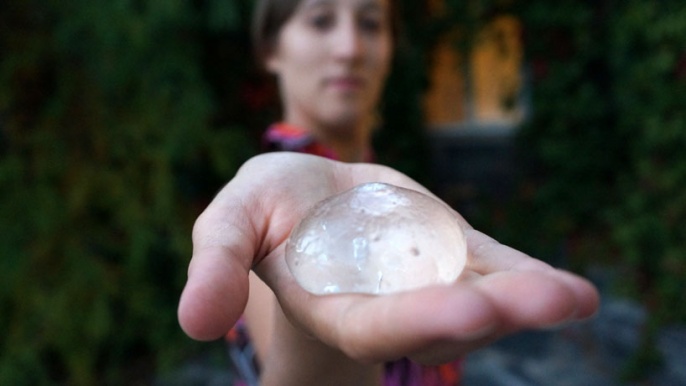
When we drink bottled water we throw away plastic, [and] 80% of the bottles are not recycled….. Ooho! uses the culinary technique of sphereification, the water is encapsulated in a double gelatinous membrane. The technique consist into apply sodium alginate (E-401) from the brown algae and calcium chloride (E-509) in a concrete proportions in order to generate a gelification on the exterior of the liquid. The final package is simple, cheap (2ct/unit), resistant, hygienic, biodegradable and even eatable. Ooho! is licensed as creative commons so everyone could make them at their kitchen, modifying and innovating the “recipe.”
Photos from DesignBoom <<
Turn A $2000 Shipping Container Into An Epic Off-Grid Home
All you need is around $2000 to begin building one of these epic homes – made from recycled shipping containers! Check out some of these amazing creations!
A luxury home doesn’t always necessarily mean thousands of square footage, towering great rooms and gilded toilets. Take these homes for example: to begin building one of these epic houses, all you need is $2,000. That $2,000 will buy you a shipping container. What you do with that shipping container… well, that’s completely up to you. Some creative people have found a way to transform this rudimentary “room” with metal siding into luxury housing that blows us away. These homes are epic.
1.) A shipping container doesn’t have to be a closed space.

2.) Blue container? Run with it!

3.) Open up the metal boxes and let your imagination run wild.

4.) *jaw drops*

5.) The shapes are basically the same, but wow.

6.) Utilitarian… and awesome.

7.) The best part about this one is that you know they made it out of shipping containers.

8.) This open concept was taken a step further with a sliding garage door.

9.) You don’t rob this house. Ever.

10.) Modern, yet … not.

11.) This is the kind of home that keeps a person happy.

12.) Already-made pool? Yes please.

13.) Recycled materials AND it’s good for the planet.

14.) This collection of containers is just epic.

15.) These are so inspiring.

If you enjoyed these what these people did with their containers then you will love this couple’s new tiny home.
The best part of the gallery that this Reddit user shared? The shipping containers are recycled materials, so you’re actually helping the environment if you invest in making a luxury shipping container home. You can’t beat a base price of $2,000. What a marvellous idea; share it with others by clicking on the Share button above/below this article.
Fossil Fuel Industry Is Quietly Building Pipeline Network That ‘Dwarfs Keystone’ XL
Despite public opposition that has so far blocked the building of the Keystone XL pipeline, the fossil fuels industry has successfully-and quietly-expanded the nation’s domestic oil network by installing thousands of miles of pipeline across the country, according to new reporting by the Associated Press.
“Overall, the network has increased by almost a quarter in the last decade,” the AP reports. “And the work dwarfs Keystone. About 3.3 million barrels per day of capacity have been added since 2012 alone-five times more oil than the Canada-to-Texas Keystone line could carry if it’s ever built.”
While the Keystone project is still in limbo, the petroleum industry has “pushed relentlessly everywhere else to get oil to market more efficiently, and its adversaries have been unable to stop other major pipelines,” writes AP journalist Henry Jackson.
That’s not to say they haven’t tried.
In Minnesota, for example, local opponents succeeded last year in getting state regulators to consider rerouting a 616-mile pipeline proposed by Toronto-based Enbridge around lakes and forests, delaying it for at least a year.
“More typical, though, was an Enbridge project to double the capacity of a 285-mile stretch of pipeline in Michigan,” Jackson writes. “Groups like the Michigan Coalition Against Tar Sands fought the proposal, citing a spill in 2010 that caused serious environmental damage. But the Michigan Public Service Commission ruled the project acceptable, and the expansion went ahead.”
Opposition to local pipeline projects is ongoing. In Iowa, the Meskwaki Indian tribe is objecting to a Texas company’s plans to construct a 343-mile crude oil pipeline across 18 Iowa counties, the Des Moines Register reported Monday.
“As a people that have lived in North America for thousands of years, we have environmental concerns about the land and drinking water,” tribal chairwoman Judith Bender wrote in a letter filed last month with state officials. “As long as our environment was good we could live, regardless of who our neighbors were.”
She continued: “Our main concern is Iowa’s aquifers might be significantly damaged. And it will only take one mistake and life in Iowa will change for the next thousands of years. We think that should be protected, because it is the water that gives Iowa the best way of life.”
An analysis released in November by the Center for Biological Diversity found that there have been more than 8,700 significant incidents with U.S. pipelines involving death, injury, and economic and environmental damage since 1986-more than 300 per year.
In fact, a new proposal from the Department of Transportation’s Pipeline and Hazardous Materials Safety Administration “is an implicit acknowledgment that some of the oil industry’s testing technology isn’t sophisticated enough to detect cracks or corrosion in time to prevent a pipeline’s failure,” according to Energy & Environment Publishing’s EnergyWire, which reported exclusively on the plan on Monday.
According to EnergyWire:
Almost two years after an Exxon Mobil Corp. pipeline split open and sent Canadian crude flowing through a neighborhood in Mayflower, Ark., federal regulators have quietly proposed a sweeping rewrite of oil pipeline safety rules.
If the proposal is finalized in its current form, as much as 95 percent of the U.S. pipelines that carry crude, gasoline and other liquids-182,000 miles-would be subject to the new rules and about half the system may have to undergo extensive tests to prove it can operate safely, according to information from the Department of Transportation’s Pipeline and Hazardous Materials Safety Administration.
The plan, known as the Hazardous Liquids Integrity Verification Process, is an implicit acknowledgment that some of the oil industry’s testing technology isn’t sophisticated enough to detect cracks or corrosion in time to prevent a pipeline’s failure. And for the first time since PHMSA was created, it may wind up telling companies they have to replace certain aging pipelines.
The oil and pipeline industries are already lobbying against the idea, EnergyWire reports, though few details about the plan are publicly available.
According to EnergyWire journalist Mike Lee: “PHMSA declined to make any of its officials available for interviews over a five-day period and wouldn’t answer written questions on the record-even though the agency has already briefed two oil industry trade associations about the proposal.”
This Dad Gives His Sick Son Marijuana Extract. The Results… Mind-blowing!
Jayden’s dad was desperate to help him overcome his epileptic seizures.
This video is from a new documentary The Culture High which looks at both sides of the marijuana prohibition argument.
After taking more than 22 pills a day, Jason decided that enough is enough and gave his son Marijuana extract. The results will surprise you.
The University of Texas also recently published their research into the long-term effects of marijuana.
Support the film and watch the full documentary today.
.
The Senate Had A Hearing On Oil Exports And Didn’t Mention The Environment Once
On Thursday, the Senate Energy Committee convened a hearing to discuss the U.S. ban on crude oil exports, which has been in place since 1973. With the United States in the midst of an oil boom – and with Americans using less gas than ever before – lifting the ban would have profound implications both at home and abroad, issues that dominated the panelists’ testimony and committee’s questions.
“The national security side will be an extremely important part of this going forward,” Chairwoman Sen. Lisa Murkowski (R-AK), said during the hearing. “We all recognize that the world is a very, very volatile place right now.”
Lifting the export ban, several panelists argued, would allow the United States to leverage more power over potential oil sanctions by assuring that the international market would remain stable. It would also, panelists said, move the center of the international oil market away from unstable countries – both Russia and Iran merited a mention – stabilizing the overall supply.
Domestically, Carlos Pascual, fellow at the Center on Global Energy Policy at Columbia University, argued that lifting the export ban would lower gas prices and boost the U.S. economy. “The critical focus on the part of Americans is price,” Pascual said. “Every single study that has been done by a major institution has come to the same conclusion: lifting the export ban will reduce the price of gasoline in the United States,” while adding $38.1 billion to the U.S. GDP by 2020.
In all these calculations, however, there was one glaring omission: no panelist – or senator – talked about how lifting the export ban would impact the environment.
“It feels ridiculous to have a discussion about lifting the ban on oil exports and not talk about climate change,” Karthik Ganapathy, U.S. communications director at 350.org, told ThinkProgress. “What it boils down to is lifting the ban encourages and incentivizes oil production in the U.S. and that’s the wrong direction.”
Lifting the crude oil export ban would increase demand for oil in the international market, which would incentivize U.S. oil companies to expand their businesses and explore new options for drilling. Most likely, that would mean the extraction of tight oil reserves – the kind of petroleum extracted from shale or sandstone through hydraulic fracking.
“Our concern is that we need to be moving away from oil,” said David Turnbull, campaigns director at Oil Change International. “We need to be not relaxing U.S. oil regulations in the context of the climate crisis.”
Here are three issues surrounding crude oil exports that weren’t mentioned in Thursday’s Senate hearing.
Greenhouse Gas Emissions
“The industry wants to lift the ban so they can increase production and have a bigger market to send their oil around,” Turnbull said. “The logical conclusion to that is that they would be ramping up production, and that has a clear climate impact.”
According to the International Energy Agency (IEA), one-third of the world’s fossil fuel reserves – including coal, oil, and natural gas – need to remain in the ground to have a 50-50 shot at staying beneath the 2° Celsius warming limit internationally agreed upon by 141 countries in the Copenhagen Accord (a limit that, by some estimates, doesn’t go far enough in protecting us from the negative effects of climate change). To raise that chance to 80 percent, only one-tenth of current fossil fuel reserves can be extracted and burned by 2050. Working under those incredibly tight parameters, a huge amount of America’s natural gas needs to remain in the Earth for the 2°C goal to be feasible.
Lifting the crude oil export ban would encourage producers to flood the market with even more crude oil, stimulating the burning of a fuel that needs to stay in the ground if the 2°C goal has any chance of being a reality. As Oil Change International warned in a 2013 report, “Without an effective international regime to keep global greenhouse gas emissions below recognized thresholds, deregulating U.S. crude oil exports can only exacerbate the impending climate crisis.”

CREDIT: Josh Burstein / NextGen Climate Action
In addition to encouraging the extraction of tight oil, lifting the export ban could increase the amount of heavy crudes – like tar sands – brought into the U.S. for refining.
“Before we had this new boom of the lighter, desirable crude, [the U.S. oil industries] built a number of refineries that are specialized in getting usable product out of heavier crude,” Janet Larsen, director of research at Earth Policy Institute, told ThinkProgress. “If we can export the lighter stuff, we may end up … sending it to places that can refine it better, and using the refineries we have to process the heavier stuff.”
That, Larsen explains, would be tantamount to an double-whammy, increasing the production of both light crude and heavier, more greenhouse gas-intensive heavy crude.
Water Concerns
If deregulating crude oil exports encourages U.S. producers to ramp up extraction of tight oil, leading to an increase in fracking, the country’s already dwindling water supply could also be on the line.
Fracking is a water-intensive process, requiring millions of gallons of water to drill a single well. In places like California, which is in the midst of a historic drought, fracking would require the diversion of precious water resources to drill for a fuel that will simply exacerbate climate change, which some say caused the drought in the first place.

CREDIT: AuntSpray
But it doesn’t take a drought to raise concerns about the impact an increase in fracking would have on water supplies. Last week, the Environmental Working Group released a report on the chemicals found in California’s fracking wastewater, listing things like “petroleum chemicals, heavy metals, and radioactive elements.”
Even in places not currently experiencing drought, fracking – which, according to the EWG, produces more wastewater than it does oil or gas – gives environmentalists pause. “Pennsylvania is not necessarily in a drought,” Turnbull said, “but that doesn’t mean that people’s drinking water should be impacted.”
Dangerous Transportation
Since mid-February, four trains carrying crude oil have derailed in the U.S. and Canada, sparking massive fires and spilling their contents into waterways and communities.
It’s becoming increasingly clear that trains are not a particularly safe method of transporting crude oil. And yet, if the export ban is lifted, oil companies looking to ship their crude overseas will have to get their oil to market somehow – either by train or pipeline.
“Transporting oil, no matter which way you do it, is not safe,” Turnbull said. “It’s a combustible fuel. It causes problems when it gets mixed with water. When a pipeline leaks in a neighborhood, it can decimate it.”
To Turnbull, the debate over relaxing crude oil export regulations highlights a dangerous chasm between energy policy and climate policy. “It’s really incoherent,” he said, “to talk about the crude export ban and relaxing oil regulations without talking about climate change.”
PHOTO CREDIT: Anan Kaewkhammul
Written By: Natasha Geiling
Scientists successfully add woolly mammoth DNA into elephant

The woolly mammoth has been extinct for some 4,000 years ago, but now, researchers are attempting to bring it back to life.
A team at Harvard University has successfully inserted woolly mammoth DNA into the genetic code of an elephant.
The project was led by Harvard genetics professor George Church. He told The Sunday Times, “We prioritized genes associated with cold resistance including hairiness, ear size, subcutaneous fat and, especially, hemoglobin.”
Church has spoken about this type of genetic splicing in elephants before.
“We would propose to make a hybrid elephant that has the best features of modern elephants and the best features of mammoths.”
The Asian elephant is the closest relative to mammoths, although the size of mammoths was similar to that of the larger African elephant.
Church’s project isn’t without its critics, though.
Some scientists are against using elephants to potentially bring back the woolly mammoths. Professor Alex Greenwood told The Telegraph: “Why bring back another elephantid from extinction when we cannot even keep the ones that are not extinct around? What is the message? We can be as irresponsible with the environment as we want. Then we’ll just clone things back?”
The Harvard-led project has not yet been submitted to a journal because the research is ongoing.
Spread Love, the world will thank you for it
Every time you wake up ask yourself “What good things am I going to do today?” Remember that when the sun goes down at sunset, it will take a part of your life with it.
Native American Proverb



